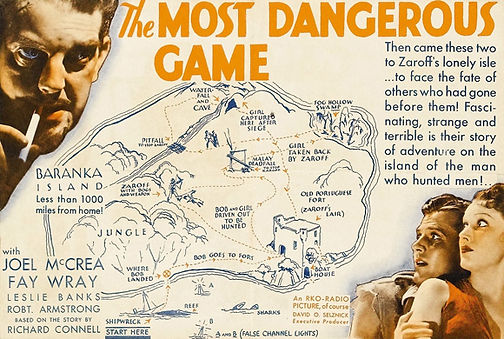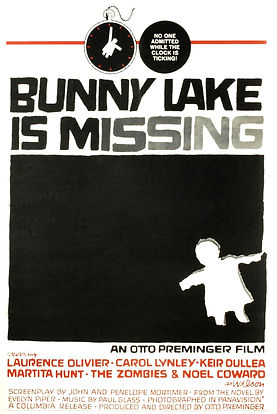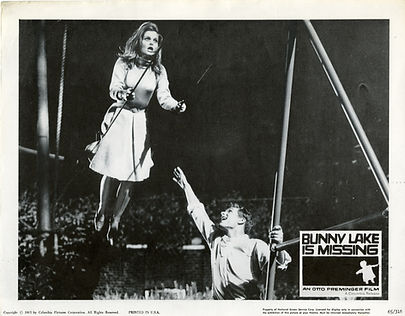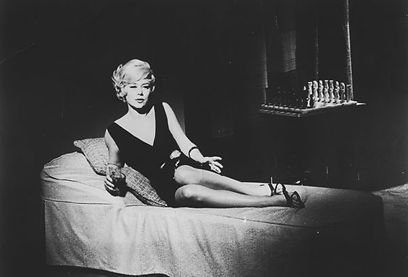
I See A Dark Theater's Seasonal Favorites: Halloween, Part 2
October 28, 2016
Welcome to I See A Dark Theater's Halloween favorites, part 2! Herein you will find three more season-friendly picks that are not intense, gory horror flicks but rather slightly creepy, totally bizarre and oftentimes psychologically manipulative films. For the most part, they are just as alarming as your run-of-the-mill suspense tale, albeit in different ways.
(For those who may have missed it, you can find last week's piece here.)

Such an entertaining poster for The Most Dangerous Game.
The Most Dangerous Game (1932)
The Most Dangerous Game presents the biggest stretch in terms of horror/thriller on this list, but that's fine, because I can bend my own rules. However, one glance at the short summary listed on IMDb is all it takes to understand why I've included this picture here:
"An insane hunter arranges for a ship to be wrecked on an island where he can indulge in some sort of hunting and killing of the passengers."
Yes, when you boil it down, the plot really is that simple. I think many would agree with me in giving this abstract a "WTF?" response. Naturally, after reading that I had to watch the film immediately, because how can you not? The movie shows shades of 1932's The Old Dark House in the beginning (basically, with an old, dark house and peculiar occupants) and then goes off the rails with Count Zaroff (Leslie Banks)'s insanely twisted manhunt. Bob Rainsford (Joel McCrea) escapes a shipwreck and swims to a nearby island. There, he comes across a mansion owned by Zaroff and meets other marooned survivors, including Eve (Fay Wray) and her brother Martin (Robert Armstrong). Zaroff explains to his guests that he's a big game hunter, but curiously each time he takes someone into his trophy room, they disappear. After Martin fails to return, Bob and Eve conduct a search and stumble upon his body. Zaroff casually admits he hunts humans, a fact Bob, a (regular) hunter himself, rightfully finds crazy. Since Bob refuses to hunt with Zaroff, Zaroff decides to target him. But Zaroff offers up a deal: Bob and Eve will gain their freedom...if they survive the night in Zaroff's jungle hell.

Zaroff (Leslie Banks), Eve (Fay Wray) and Bob (Joel McCrea). Everything seems totally fine, right?
The pre-Code date on this one allows for some fun, mainly in the story. Seriously, I doubt a film could get away with such a clearly enunciated violent subject - "outdoor chess," as Zaroff calls it - for a great many years. The last 20-25 minutes consist of a tense cat and mouse game in which Bob and Eve run for their lives as Zaroff progresses from bow and arrow to gun to wild dogs in his quest to take them down, while Bob is equipped with a measly knife and a head start.
The jungle race in the second half also boasts some excellently captured sequences that showcase very early film noir leanings, or perhaps influences from the German expressionist period - or both. In particular, the final few frames powerfully convey so much in one shot: life, death, beginning and end. It's quite a suitable finale and spot on in its suggestive violence and horror.

Such a brillant poster. Famed designer and frequent Otto Preminger collaborator Saul Bass designed the poster and title sequence for this movie.
Bunny Lake is Missing (1965)
When discussing Bunny Lake is Missing, I frequently find myself reverting back to The Innocents. Yes, again. Why? Besides boasting fantastic opening credits and featuring uncertain realities as centerpieces, both films share a very distinct disturbing quality having to do with relationships: The Innocents' involves everyone - but especially Miles - while Bunny Lake is Missing concerns a brother who is certainly off in some way (and almost looks like a grown up version of Miles).
In Bunny Lake is Missing, young mother Ann Lake (Carol Lynley) relocates to England and drops daughter Bunny off at her first day of school. However, when she arrives to pick Bunny up, the girl is nowhere to be found; in fact, the school has no record of Bunny ever being registered. Ann contacts the authorities, and Superintendent Newhouse (Laurence Olivier) is assigned to the case. As he digs deeper into the investigation, Newhouse begins to doubt that Bunny ever existed in the first place, a claim that Ann's brother Steven (Keir Dullea) seems to back up in strange ways.

Contrary to what this still may appear to imply, no one is possessed in this film. Not even Ann (Carol Lynley) or Steven (Keir Dullea).
The sum of the cast's talents, the writing and the direction in Bunny Lake is Missing create the uncertain world Newhouse navigates to get to the bottom of Ann's case. John and Penelope Mortimer's script imbues the premise with a variety of characters who run the gamut of grounded, colorful and downright disturbed. At the same time, Otto Preminger's direction, darkly complimented by Denys N. Coop's cinematography, maintains a very close relationship with the proceedings, which serves to transport the audience into the story as Ann and Newhouse explore the nooks and crannies of the school and other settings in rather long takes.
Certainly, an important factor involves the relationship between Ann and Steven, one which exhibits a suspicious intimacy early on, to say the very least. I have always been impressed with the way in which Lynley and Dullea flow in and out of two worlds: the reality of adulthood and their shared, lingering children's play world. Similar to The Innocents, the balance makes for a very unnerving viewing experience that, in opposition to the aforementioned, becomes very apparent in the extremely unsettling and drawn out final act.

What a tagline!
The Cabinet of Caligari (1962)
The 'Dr.' was dropped from the title but the insanity multiplied in this bizarre American re-envisioning of 1920's The Cabinet of Dr. Caligari. Both films screened together at LACMA in 2014, which was certainly a double feature to behold. The abstract expressionism so famous in the German version takes a back seat in the 1962 remake, relegated to its supporting role by a hyper psycho-sexualized doctor who harbors some serious issues, among them an unfortunate obsession for Jane (Mary Poppins' Glynis Johns). Though incredibly odd, I also found the film fascinating, which led me to track down the DVD.
When Jane (Glynis Johns)'s car breaks down, the closest residence she finds belongs to the charming Caligari (Dan O'Herlihy). Well, he's charming at first. Happy that she's found a welcoming place while she figures out her car situation, Jane's relief soon turns to horror as she seems unable to find a way out of the estate; to her further confusion, Jane also realizes none of the other guests appear to mind their ostensibly permanent lodgings. As it becomes clear to Jane that Caligari's got his very disturbed eye on her in more ways than one, she turns in increasing desperation into his freakish world to fight fire with fire.

Trust her, Jane (Glynis Johns), things are going to get weird. Or don't trust her.
Caligari isn't a straight remake of the Dr. version, but a twisted reimagining, you could say, and it easily ranks as the most bizarre entry on this list. If you've watched Mary Poppins (1964) and remember Mrs. Banks, well, you'll see her in complete opposite mode - and in a lot less clothing at one point - here. I'm not very familiar with Johns' work, but I was impressed by her performance, in particular how she handled the psychological rifts of a character who is thrown into such an eccentric, unsettling situation.
Caligari moves slowly at times, but that's deliberate. In fact, every aspect of the movie is meticulously calculated. The picture has a habit of placing the viewer in an altered state, one of slight discomfort; however, by the end - or in re-watching - I think that feeling lessens or vanishes altogether, due to the plot twist in the third act. I was also surprised to find that this was an American film, not British as I originally thought; the sexually suggestive and voyeuristic storylines, not to mention the surprising bouts of fleeting violent imagery, certainly took me aback, even for the early 1960s. Oh, and it would be remiss of me not to point out Gerald Fried's omnipresent score, which diligently serves to take the viewer on this wild ride alongside Jane and underline the chaos surrounding her.
Fun fact: Caligari shares the same writer (Robert Bloch) and cinematographer (John L. Russell) as Psycho (1960), which has made me wonder what Hitchcock would have done with this material!
What are some of your favorite movies to watch around Halloween?
thanks for stopping by!
I See a Dark Theater is a website dedicated to classic movie-going—and loving—in the City of Angels. Whether it's coverage on screenings, special presentations, or Q&As around Los Angeles that you're looking for, or commentary on the wonderful and sometimes wacky world of classic cinema, you've come to the right place for a variety of pieces written with zeal, awe, and (occasionally) wit. Enjoy.

